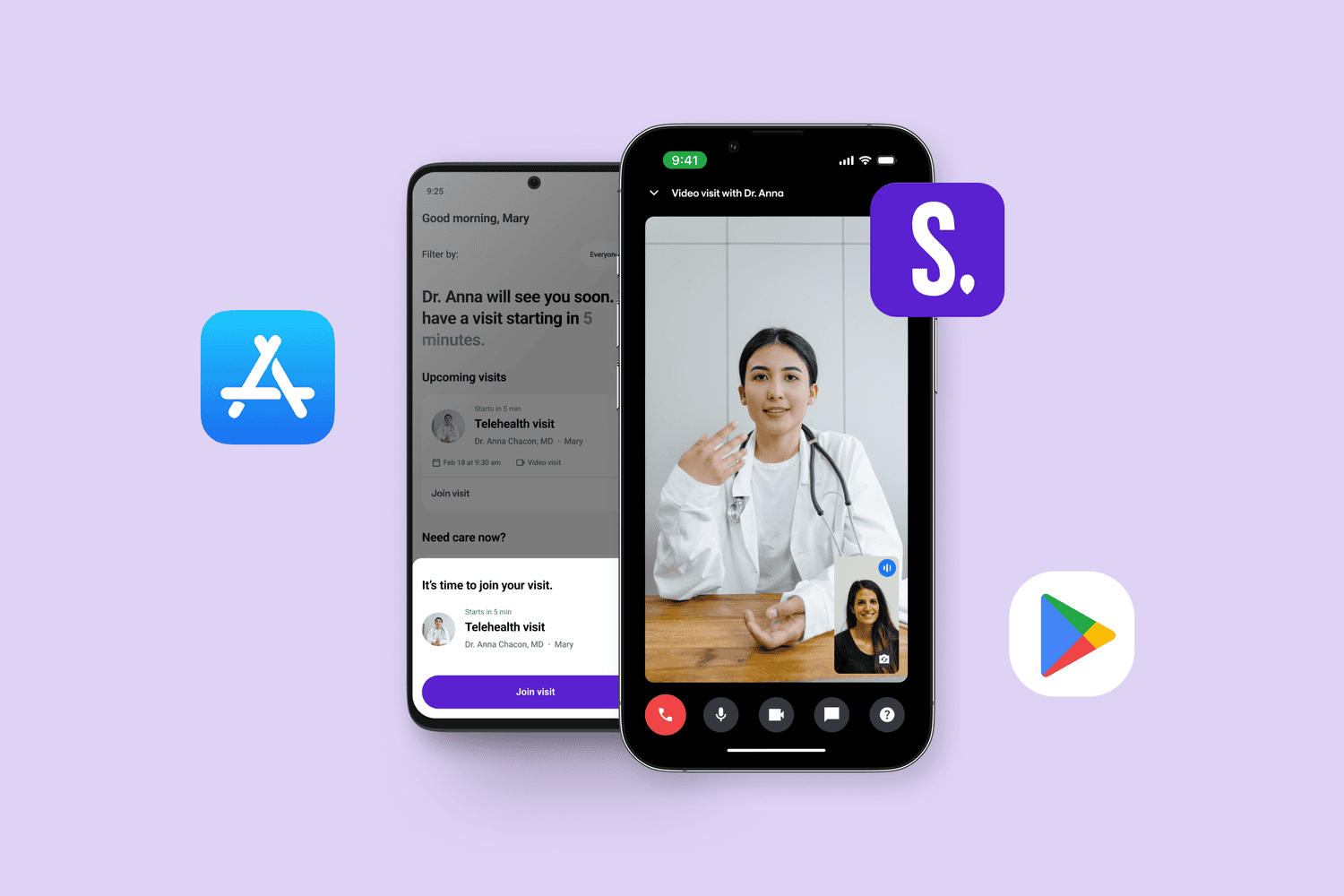Wegovy vs Ozempic: Which Works Better?
Key takeaways
- Both Wegovy and Ozempic contain the same active ingredient (semaglutide), but Wegovy is approved specifically for weight loss, while Ozempic is approved for the treatment of type 2 diabetes.
- Overall, Wegovy may lead to greater weight loss than Ozempic because it’s usually prescribed at a higher dose.
- If you're insured, the price of Wegovy and Ozempic will vary based on your health plan; without insurance, Wegovy is around $1,349/month while Ozempic costs around $998/month. Both medications are available to self-pay patients for $349/month.
Have questions about Wegovy or Ozempic? You’re not alone! Both medications share the same active ingredient, semaglutide. They're also manufactured by pharmaceutical company Novo Nordisk.
However, Wegovy and Ozempic are approved for different health conditions, and that’s where the confusion often begins. Are they equally effective for weight loss? Does one work better for blood sugar control? And what about side effects and medication price?
In this post, we’ll break down how Wegovy and Ozempic compare and what sets them apart, so you can make a more informed decision with your healthcare provider.
Wegovy vs Ozempic: What’s the difference between them?
Wegovy and Ozempic are brand names for the same drug: semaglutide. Despite sharing the same active ingredient, they are approved by the Food and Drug Administration (FDA) for different health conditions.
Wegovy is approved for chronic weight management for those aged 12 and older with obesity or who are overweight with at least one weight-related condition, such as high blood pressure, high cholesterol, or type 2 diabetes.
Ozempic, on the other hand, is approved for the treatment of type 2 diabetes in those 18 and older. It's also FDA-approved to treat chronic kidney disease in diabetic patients.
Both Ozempic and Wegovy are injectable medications. They’re typically prescribed as a once-weekly subcutaneous injection (an injection that is delivered just below the skin) using a pre-filled injection pen. Health care providers will usually prescribe a lower dosage at first, which will then be titrated (slowly increased) over several weeks to let your body adjust to the medication’s effects.
Semaglutide and other GLP-1s prevent excess hunger caused by low blood sugar, causing you to feel less hungry (and consume less food as a result). For this reason, health care providers are increasingly prescribing GLP-1 diabetes medications like Ozempic as an off-label way of helping patients achieve and maintain a healthy weight.
How do Wegovy and Ozempic work?
Both medications belong to a class of medications known as GLP-1 receptor agonists, which aid with blood sugar stabilization and appetite reduction. Here’s how:
Blood sugar stabilization: GLP-1 is a naturally-occurring hormone that is released by your body when you eat food; the GLP-1 signals to your pancreas that it’s time to release insulin, a hormone that helps blood sugar (glucose) enter your cells for energy. However, if you have type 2 diabetes, your cells aren’t responding to insulin as they should, which means that blood sugar is not properly absorbed and your blood sugar levels can become too high or too low.
GLP-1 receptor agonist medications resolve this problem by mimicking GLP-1s and telling the pancreas to release more insulin, helping to regulate and stabilize your blood sugar levels. GLP-1s also suppress glucagon, which raises blood sugar levels by promoting the release of glucose from the liver. By reducing glucagon secretion, GLP-1 helps maintain steady blood sugar levels and prevents excessive hunger caused by low blood sugar.
Appetite reduction: The GLP-1 hormone has receptors in the hypothalamus, a part of the brain that regulates hunger and satiety. When GLP-1 binds to these receptors, it sends signals to your brain to decrease your appetite and food cravings. This helps you feel less hungry and more satisfied with smaller meals.
The hormone also slows down your gastric motility (how quickly your intestines move food through your body). By slowing down your gastric emptying, the GLP-1 causes you to feel more full. This decreases your appetite and calorie intake and leads to weight loss.
How effective is Wegovy vs Ozempic?
Since Wegovy is indicated for weight loss and Ozempic is indicated for type 2 diabetes, they can't be compared directly. However, Wegovy has been shown to cause more weight loss than Ozempic, in large part because Wegovy is prescribed at a higher dose than Ozempic.
In clinical trials, patients who were taking 2.4mg of semaglutide (the standard Wegovy dosage) lost an average of 15% of their body weight over 68 weeks.
However, it’s important to note that Ozempic is only prescribed in .5 mg, 1 mg, or 2 mg dosages (not 2.4mg, as it was during clinical trials). This means that while you can still lose weight with Ozempic, the weight loss will likely not be as drastic as the weight loss experienced by clinical trial participants.
Who is eligible for Wegovy?
Yu may be eligible for Wegovy if you have a body mass index (BMI) of 30 or higher (obesity). You may also qualify for it if you have a BMI of 27 or higher (overweight) with at least one weight-related condition such as hypertension, type 2 diabetes, or high cholesterol. It's important to note that Wegovy is meant to be used alongside lifestyle changes like diet and exercise.
The most common side effects of Wegovy are gastrointestinal issues that include nausea, vomiting, diarrhea, constipation, heartburn and belching.
More serious side effects may occur, but they are uncommon. Some serious adverse effects of Wegovy use include:
- Increased heart rate
- Low blood sugar (hypoglycemia)
- Allergic Reactions: Rash, swelling, breathing difficulties
- Pancreatitis (inflammation of the pancreas)
- Gallbladder problems, including gallstones
- Increased risk of thyroid cancer
Health care providers may avoid prescribing Wegovy for people with:
- A history of pancreatitis
- Gallbladder problems
- Kidney disease
- Thyroid disorders (like medullary thyroid carcinoma)
- Multiple Endocrine Neoplasia syndrome type 2 (MEN 2)
- Retinopathy (eye problems)
- Any digestive disorders
If you experience any side effects while taking Wegovy, immediately seek medical attention from a licensed health care provider. You should also avoid Wegovy if you are pregnant, trying to become pregnant, or breastfeeding; it is unknown if Wegovy can pass into your breast milk, and it has not been studied in pregnant women.
Who is eligible for Ozempic?
Ozempic is prescribed for adults with type 2 diabetes to improve blood sugar control. It is not for treating type 1 diabetes or diabetic ketoacidosis. Patients using Ozempic may also have associated health conditions like heart disease or high blood pressure.
The most common side effects of Ozempic are gastrointestinal issues that include nausea, diarrhea, vomiting, and constipation.
Less common but more severe adverse events may include:
- Pancreatitis (inflammation of the pancreas)
- Low blood sugar (hypoglycemia)
- Vision changes
- Increased risk of thyroid cancer or tumors
- Allergic reactions like skin rash, swelling, breathing difficulties
In addition, Ozempic may not be safe for certain individuals with previously diagnosed medical conditions.
Health care providers may avoid prescribing Ozempic for people with:
- A history of pancreatitis
- Gallbladder problems
- Kidney disease
- Thyroid disorders (like medullary thyroid carcinoma)
- Multiple Endocrine Neoplasia syndrome type 2 (MEN 2)
- Retinopathy (eye problems)
- Any digestive disorders
Ozempic may not be prescribed to pregnant women, women who are trying to conceive, or women who are breastfeeding.
How much do Wegovy and Ozempic cost?
If you’re insured, the price of Wegovy and Ozempic will depend on the rates negotiated by your insurer. It’s best to call your insurer directly to understand your coverage and out-of-pocket costs.
Without insurance, Wegovy is priced at $1,349.02 per month. In November of 2025, Novo Nordisk also announced a more affordable option: uninsured patients (or those who have insurance that doesn't cover Wegovy) can access all dose strengths of Wegovy at a reduced cash price of $349 per month via a direct-to-consumer online pharmacy.
Without insurance, Ozempic costs about $998 per month. In November of 2025, Novo Nordisk announced that self-pay patients can access Ozempic at a reduced cash price of $349 per month via a direct-to-consumer online pharmacy. Like with Wegovy, this option is only available to those without insurance or those without insurance coverage for Ozempic.
How Sesame can help
Sesame offers an affordable and comprehensive online weight loss program to help you get started on your weight loss journey. Success by Sesame is a month-to-month subscription that includes a video consultation with a weight loss doctor or specialist of your choice, access to prescriptions for weight loss medication if appropriate, unlimited messaging with your provider, ongoing support, and more.
Maintaining a healthy weight can lead to significant health benefits, including a lower risk of heart disease, improved mobility, better sleep, and enhanced overall well-being. Get started on your weight loss journey today. Note that all prescriptions are at the discretion of your healthcare provider.
Related posts

Learn about the key differences between GLP-1 medications Ozempic (semaglutide), Wegovy (semaglutide) and Mounjaro (tirzepatide).

Compare the effectiveness, side effects and prices of weight loss and diabetes medications Mounjaro and Wegovy.

Ozempic (semaglutide) is a prescription diabetes drug also used to help with weight loss. Ozempic also reduces the risk of heart problems and heart disease..

Drinking alcohol while on Ozempic could increase your risk for low blood sugar, gastrointestinal upset and more. Learn about side effects, risks and more.

This article will examine Ozempic’s efficacy as a weight loss drug, how it works, and what to consider before taking it.

Are they the game-changers they're touted to be in the realm of weight loss? How safe and effective are diabetes medications when used for weight loss? And how do you know if they’re right for you?

Saxenda (liraglutide) is among the growing list of diabetes medications being used for weight loss. This article will explain some basic facts about Saxenda.

Learn how Costco Members can get prescriptions for Ozempic and Wegovy at half the price, no insurance required.

Discover key features of Sesame’s new mobile app, including video visits, provider messaging, Rx tracking and more.
